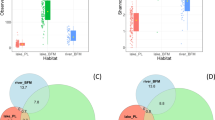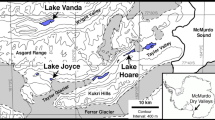Abstract
We characterized the richness of benthic cyanobacteria and diatoms in a salina system using traditional and molecular biological methods. After determining the different morphotypes and 16S rRNA genes present in various localities within this hypersaline system, an analysis of the increase of organismal richness as a function of numbers of samples considered was carried out. We found that the spatial scales of sampling yielding significant increases in cumulative richness were those at which significant variations in environmental parameters (salinity, vertical microgradients) are known to exist, indicating that the presence of environmental gradients contributes to increased biodiversity. Additionally, we could use this type of cumulative analysis for the estimation, through asymptotic extrapolation, of the total richness of oxygenic phototrophs present in the entire salina system, and for the estimation of the average degree of dissemination of community members within the system. We found interesting differences between analyses based on morphotypes or 16S rRNA genes. The cumulative number of rRNA gene sequences exceeded that of morphotypes by more than two-fold. This indicates that many organisms possessing distinct 16S rRNA gene sequences could not be distinguished on the basis of morphology. Thus, some of the apparently widely distributed morphotypes may in fact conceal several ecologically independent genotypes.
Similar content being viewed by others
References
Anagnostidis, K. & Komárek, J., 1985. Modern approach to the classification system of cyanophytes. 1. Introduction. Arch. Hydrobiol. Suppl. 71: 291–302.
Baas-Becking, L. G. M., 1934. Geobiologie of inleiding tot de milieukunde. Den Haag, The Netherlands.
Brosius, M., T. Dull, D. D. Sleeter, & H. F. Noller, 1981. Gene organization and primary structure of a ribosomal RNA operon from Escherichia coli. J. Mol. Biol. 148: 107–127.
Castenholz, R. W., 1992. Species usage, concept, and evolution in the Cyanobacteria (blue-green algae). J. Phycol. 28: 737–745.
Castenholz, R. W., 1996. Endemism and biodiversity of thermophilic cyanobacteria. Nova Hedwigia 112: 33–47.
Castenholz, R. W. & J. B. Waterbury, 1989. Oxygenic phototrophic bacteria, group I. Cyanobacteria. In Bryant, M. P., N. Pfennig & J. G. Holt. Baltimore, Md. (eds), Bergey's Manual of Systematic Bacteriology. The Williams and Wilkins Co.: 1710–1728.
Clavero, E., J. O. Grimalt, V. Merino, & M. Hernández-Mariné, 1994. Structure of the sediment at depositional saline environments. In Stal L. J. & P. Caumette (eds), Microbial Mats – Structure, Development and Environmental Significance. Springer Verlag: 91–96.
Colwell, R. K. & J. A. Coddington, 1994. Estimating terrestrial biodiversity through extrapolation. Phil. Trans. R. Soc. Lond. B 345: 101–118.
Des Marais, D. J., 1995. The biogeochemistry of hypersaline microbial mats. Adv. Microb. Ecol. 14: 251–274.
Ehrlich, A. & I. Dor, 1985. Photosynthetic microorganisms of the Gavish Sabkha. In Friedman G. M. & W. E. Krumbein (eds), Hypersaline Ecosystems. Berlin Heidelberg, Germany: Springer Verlag.
Felske, A. & A. D. L. Akkermans, 1998. Spatial homogeneity of abundant bacterial 16S rRNA molecules in grassland soils. Microb. Ecol. 36: 31–36.
Fenchel, T., 1993. There are more small than large species? OIKOS 68: 375–378.
Ferris, M. J., A. L. Ruff Roberts, E. D. Kopczynski, M. M. Bateson & D. M. Ward, 1996. Enrichment culture and microscopy conceal diverse thermophilic Synechococcus populations in a single hot spring microbial mat habitat. Appl. environ. Microbiol. 62: 1045–1050.
Garcia-Pichel, F., M. Kühl, U. Nübel & G. Muyzer, 1999. Salinitydependent limitation of photosynthesis and oxygen exchange in microbial mats. J. Phycol. 35: 227–238.
Garcia-Pichel, F., M. Mechling & R. W. Castenholz 1994. Diel migrations of microorganisms within a benthic, hypersaline mat community. Appl. environ. Microbiol. 60: 1500–1511.
Garcia-Pichel, F., U. Nübel & G. Muyzer 1998. The phylogeny of unicellular, extremely halotolerant cyanobacteria. Arch. Microbiol. 169: 469–482.
Garcia-Pichel, F., L. Prufert-Bebout & G. Muyzer 1996. Phenotypic and phylogenetic analyses show Microcoleus chthonoplastes to be a cosmopolitan cyanobacterium. Appl. environ. Microbiol. 62: 3284–3291.
Golubic, S., 1980. Halophily and halotolerance in cyanophytes. Origins of life 10: 169–183.
Javor, B., 1989. Hypersaline environments. Berlin, Germany: Springer Verlag.
Jørgensen, B. B., N. P. Revsbech & Y. Cohen, 1983. Photosynthesis and structure of benthic microbial mats: microelectrode and SEM studies of four cyanobacterial communities. Limnol. Oceanogr. 28: 1075–1093.
Komárek, J., 1996. Towards a combined approach for the taxonomy and species delimitation of picoplanktic cyanoprokaryotes. Arch. Hydrobiol. Suppl. 117: 377–401.
Montoya T. H. & S. Golubic, 1991. Morphological variability in natural populations of mat-forming cyanobacteria in the salinas of Huacho, Lima, Peru. Algol. Studies 64: 423–441.
Nübel, U., B. Engelen, A. Felske, J. Snaidr, A. Wieshuber, R. I. Amann, W. Ludwig & H. Backhaus, 1996. Sequence heterogeneities of genes encoding 16S rRNAs in Paenibacillus polymyxa detected by temperature gradient gel electrophoresis. J. Bact. 178: 5636–5643.
Nübel, U., F. Garcia-Pichel & G. Muyzer, 1997. PCR primers to amplify 16S rRNA genes from cyanobacteria. Appl. environ. Microbiol. 63: 3327–3332.
Nübel, U., F. Garcia-Pichel, M. Kühl & G. Muyzer, 1999. Quantifying microbial diversity: morphotypes, 16S rRNA genes, and carotenoids from oxygenic phototrophs in microbial mats. Appl. environ. Microbiol. in press.
Pace, N. R., 1997. A molecular view of microbial diversity and the biosphere. Science 276: 734–740.
Palys, T., L. K. Nakamura & F. M. Cohan, 1997. Discovery and classification of ecological diversity in the bacterial world: the role of DNA sequence data. Int. J. syst. Bacteriol. 47: 1145–1156.
Revsbech, N. P. & B. B. Jørgensen, 1986. Microelectrodes: their use in microbial ecology. Adv. Microb. Ecol. 9: 293–352.
Round, F. E., R. M. Crawford & D. G. Mann, 1990. The diatoms: morphology and biology of the genera. Cambridge, UK: Cambridge University Press.
Siefert, J. L. & G. E. Fox, 1998. Phylogenetic mapping of bacterial morphology. Microbiology 144: 2803–2808.
Tiedje, J. M., 1995. Approaches to the comprehensive evaluation of prokaryote diversity of a habitat. In Allsopp D., R. R. Colwell & D. L. Hawksworth (eds), Microbial Diversity and Ecosystem Function. CAB International. Oxon, UK: 73–87.
Ward, D. M., 1998. A natural species concept for prokaryotes. Curr. Opin. Microbiol. 1: 271–277.
Author information
Authors and Affiliations
Corresponding author
Rights and permissions
About this article
Cite this article
Nübel, U., Garcia-Pichel, F., Kühl, M. et al. Spatial scale and the diversity of benthic cyanobacteria and diatoms in a salina. Hydrobiologia 401, 199–206 (1999). https://doi.org/10.1023/A:1003702814150
Issue Date:
DOI: https://doi.org/10.1023/A:1003702814150




